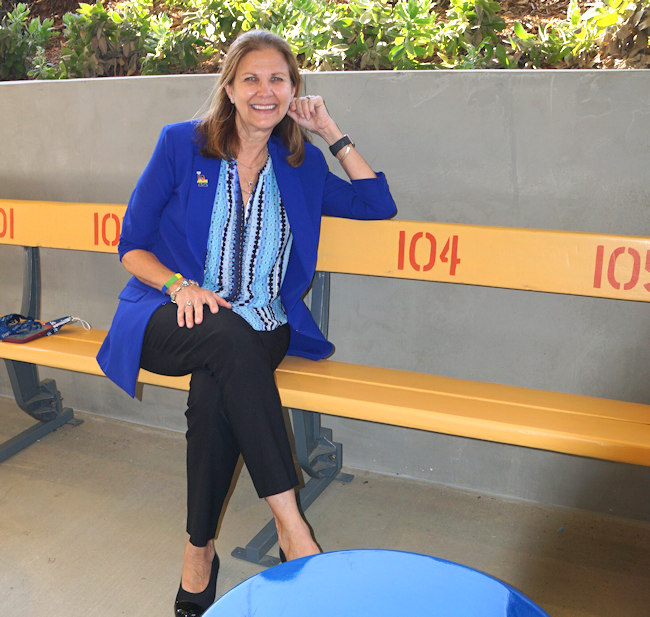
Article and all photos by Joe Mock, BaseballParks.com
All rights reserved
LOS ANGELES “The first thing you need to know about Janet is that she’s from another planet,” says Larry Lucchino.
| Janet Marie Smith stats |
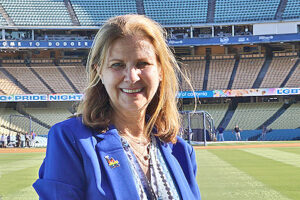 |
| Were you aware that Janet Marie Smith has been involved in so many sports facilities? |
| Oriole Park at Camden Yards 1992 |
| Turner Field 1997 |
| Conseco Fieldhouse (now Bankers Life Fieldhouse) 1999 |
| Philips Arena (now State Farm Arena) 1999 |
| Petco Park 2004 |
| Fenway Park renovations 2003-2009 |
| Ed Smith Stadium renovation 2011 |
| Oriole Park at Camden Yards 20th anniversary renovation 2012 |
| JetBlue Park 2012 |
| Rose Bowl renovations 2013 |
| Campo Las Palmas complex renovation 2017 |
| Dodger Stadium renovations 2013-2021 |
| Polar Park 2021 |
| Citizens Bank Park 20th anniversary renovations 2024 |
| NOTE: the projects in bold are ones where Smith had primary responsibility. Non-boldface means she consulted on the project. |
The former president of the Baltimore Orioles, San Diego Padres and Boston Red Sox knows Janet Marie Smith as well as anyone, as he brought her on board at all his stops – including his current role as Chairman of the Board of the Minor League Worcester Red Sox.
Her ability to plan and implement the design of new ballparks or renovations of very, very old ballparks is uncanny. Or some might say, otherworldly.
“She can sleep for just four or five hours per night,” Lucchino explains. “And she has a tolerance for travel that people from this planet don’t have. It’s positively alien.” Those traits made it possible for her fingerprints to be all over Oriole Park at Camden Yards in Baltimore, Turner Field in Atlanta and the massive renovations at Fenway Park in Boston and Dodger Stadium in Los Angeles. And she accomplished this while dealing with the male-dominated worlds of architecture and construction.
Lucchino first became aware of Smith in 1989 while he was president of the Orioles. The front office was consumed with the planning of the ballpark that would become Camden Yards. His head of Human Resources brought him a stack of letters to sign. They were all rejections of aspiring job applicants.
One jumped out at him.
He told his HR head “I can’t stand all these other folks, but this woman is an architect by training, an urban planner and has a graduate degree. I’m drowning in all of this Camden Yards stuff right now, and those are the areas where we need help. Invite her in.”
When she arrived for the interview, Lucchino wouldn’t permit her to sit down until she answered one question: “Which league has the Designated Hitter?”
Recognizing that the query was a bit sexist, she shot back “I’m offended by the question.” She quickly added that she loves the sport of baseball.
“So we sat down and here we are. It was the best free-agent signing the Orioles had in 1989,” quips Lucchino
Thus began the career of one of the most accomplished ballpark specialists the sport has ever seen.
ORCHESTRA CONDUCTOR
Exactly what is Smith’s role for a Major League team? Construction super? Architect? Urban planner? Preservationist? Baseball historian? Real-estate developer? Project manager? Club presidents who have employed her say she’s all of these. She describes her job as being like the director of a movie or an orchestra conductor.
“As a conductor, she knows the role of every single instrument,” President and CEO of the Los Angeles Dodgers Stan Kasten tells USA TODAY Sports. “That’s what makes her so good at what she does.”
The Jackson, Mississippi native graduated from the Mississippi State School of Architecture before obtaining a master’s degree in urban planning at CCNY. Baltimore was a city she studied while working on her degrees. “I was interested in the way Baltimore had reinvented itself with the waterfront Harbor Place and Festival Market,” Smith recalls.
While she was disappointed when she read that the Orioles wanted to leave venerable Memorial Stadium for a new facility downtown, “I had this eureka moment that, wow, Baltimore is reinventing itself again. It was the first time a baseball team had gone into the heart of a city in generations.
“I felt I could bring something to that,” she says.
Once Lucchino brought Smith to Baltimore, she began learning the Orioles organization and meeting with architects and contractors. Joe Spear, founder of HOK, now called Populous, recalls those meetings 30 years ago. “She impressed me as confident, smart and talented. She is a real baseball fan and as such, she understood the sport in a genuine fashion, not just academically or from a business standpoint.”
Adds Lucchino, “We basically put her in charge. She gave life to our concepts.”

As Camden Yards opened to rave reviews in 1992, executives from other MLB teams wanted to see it for themselves. One given a tour by Smith was Kasten, then the president of the Atlanta Braves. “It was obvious she had a command of both the game and the business. She had a real passion for it,” he recalls.
His Braves were facing a major transition. As soon as the 1996 Summer Olympics were concluded, the stadium used for the major events was to be converted into a baseball venue to be called Turner Field. Kasten put Smith in charge of the transformation.

Because Kasten was also the president of the NBA’s Atlanta Hawks, he made Smith responsible for the design and construction of Philips Arena, now called State Farm Arena. It opened in 1999. “It turned out fantastic, because it was a unique design that brought the upper deck 60 feet closer than in any other modern arena,” he says.
While working for Kasten in Atlanta, Smith found time to do consulting for her former boss Lucchino, who in 1995 had become president of the San Diego Padres. She assisted with plans for the ballpark that became Petco Park, which – after numerous delays — opened in 2004.

In 2002, Lucchino had set his sights on Boston, where he was part of a group trying to purchase the Red Sox. The other potential owners wanted to build a new ballpark. “We were the only group of the six that was committed to staying at Fenway Park,” he recalls. Once Lucchino’s group was installed as owners, he came calling on Smith for a third time.
“We were the ones who had built new parks in Baltimore and San Diego, so the irony was that we were the guardians of the old park,” he says. He put Smith in charge of updating Fenway without destroying its sense of history and charm. That included the installation of the Green Monster Seats in 2003.
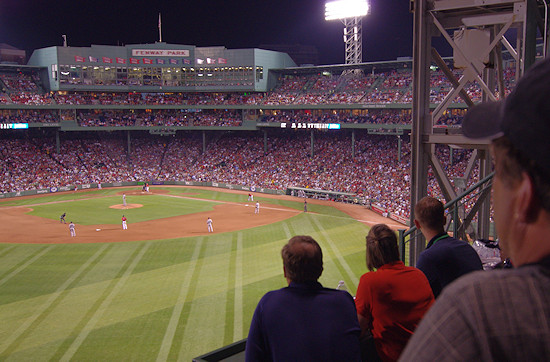
“Janet and I spent 10 years working on the ‘annual renovation’ of Fenway,” jokes Lucchino. “There was a compatibility between us and I trusted her completely.”
That’s why he also asked Smith to provide her thoughts on JetBlue Park in Fort Myers, the Red Sox spring home since 2012. It turned out to be one of the showplaces of spring training.
BACK WITH THE O’S
From 2009 to 2012, Smith was back with the Orioles, working under owner Peter Angelos. While she provided significant guidance on the architectural changes to prepare Camden Yards for its 20th anniversary season, her primary responsibility was renovating the Orioles’ spring-training facilities in Sarasota. This involved modernizing the Minor League complex at Twin Lakes Park – now called the Buck O’Neil Complex — and overseeing a complete overhaul of Ed Smith Stadium, where the exhibition games are played.
Most people would’ve looked at dumpy Ed Smith Stadium and decided to demolish it and start over. Not Smith. “It’s so frustrating to me to see buildings discarded when they still have a lot of life left in them,” she says. She brought in architect David Schwarz to provide an inspired Spanish-influenced wrap between the old parts of the stadium and the streets outside. The result was magical.
“That was a fantastic project,” she recalls. “I loved working on that little Ed Smith Stadium, which had not much charm to it, but it had good bones. That was a really joyous success to me.” In 2018, a data-mining firm determined that fans ranked the rebuilt park in Sarasota highest of all 23 spring training stadiums.

DODGER STADIUM’S NEW FRONT DOOR
Kasten was part of Guggenheim Baseball Management that purchased the Dodgers in 2012. He wasted no time in asking Smith to assess Dodger Stadium to see what improvements could be made quickly. She pinpointed $100 million worth of renovations that could be done in that first offseason. “We had original plumbing and wiring in here, and that had to be addressed,” he says. Other improvements included wider concourses, larger bathrooms, more food-prep areas and significantly larger spaces for players.
Also during her second stint with Kasten was the modernization of Campo Las Palmas in the Dominican Republic. “The Dodgers were the first to build a facility in the Dominican, but it was 30 years old and really in need of a total overhaul,” explains Smith. “That project was very rewarding to me.”
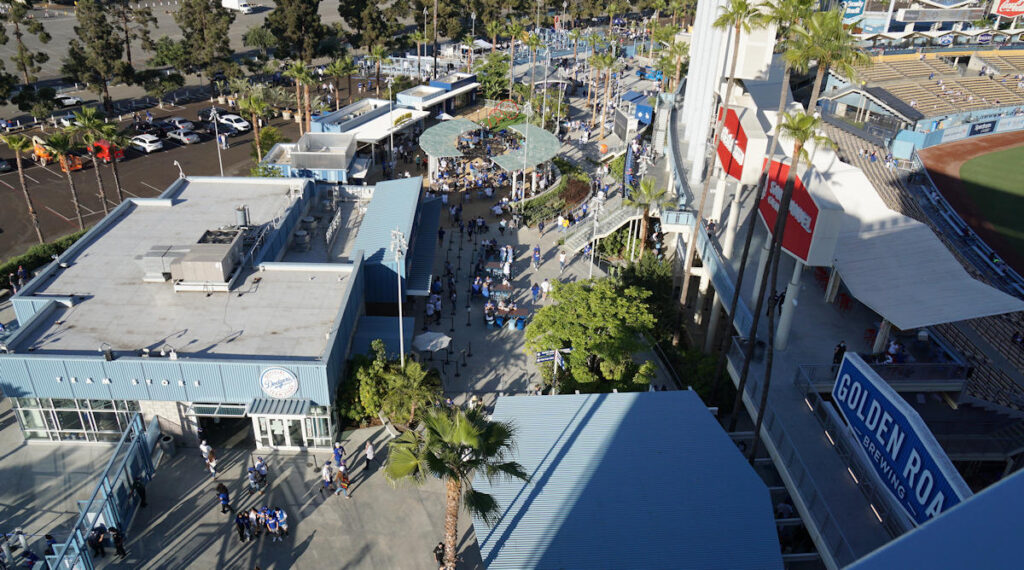
She continued to oversee smaller renovations in Dodger Stadium, culminating in a major re-imagining of the space beyond the outfield pavilion seats that opened this season. The Centerfield Plaza (photo above), which Kasten refers to as “Dodger Stadium’s new front door,” provides a major new entry point to the ballpark close to the majority of the parking lots. In addition to new food, drink and entertainment options, there are new escalators, elevators and bridges that permit fans to make a 360-degree trek around the stadium.
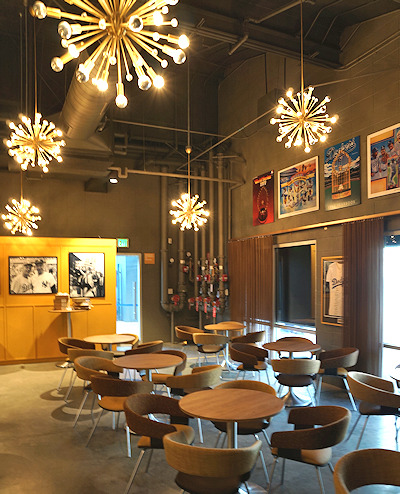 There’s even a bar that Smith refers to as a “speak easy” because it’s tucked away under the stands (see photo). All of the furniture, fixtures and décor mirror the Stadium Club the year the park opened in 1962. Walking into this bar feels like you’ve been transported back 60 years. Smith and her team pulled this off brilliantly.
There’s even a bar that Smith refers to as a “speak easy” because it’s tucked away under the stands (see photo). All of the furniture, fixtures and décor mirror the Stadium Club the year the park opened in 1962. Walking into this bar feels like you’ve been transported back 60 years. Smith and her team pulled this off brilliantly.
The plans called for the back rows of benches in the pavilion seats to be removed, allowing handicapped seating where there was none before. In addition to creating a patio behind the new back row, fans can now access all sections of the pavilion tremendously easier than before.
Never one to allow materials to go to waste, Smith repositioned some of those removed benches to walkways below the stands (photo below). She says it’s one of her favorite places to sit and relax.
Kasten was adamant that the view beyond the outfield of Dodger Stadium not be diminished by all of the changes. “The beauty of the new plaza is what it has added for the fans, and we haven’t touched the postcard (view). That has been an article of faith for both Janet and me. That will never change. It’s so important that the people who have been sitting here for 60 years feel as comfortable and familiar as they ever have, but with 21st Century amenities.
“I’m very proud of all of the work that Janet did, and all the people who worked with her and for her.”
No fewer than 14 firms worked on the new Centerfield space, a great testament to Smith’s ability to coordinate major projects – you know, like the conductor of an orchestra. Kasten says of Smith, “There’s no one who knows how to put these things together better. I can’t think of anyone who has a better command of all of these facets than Janet.”
In case you couldn’t tell, this is serious business to Kasten. “This is the best thing I’ve ever done. It’s the most fun I’ve ever had. It’s also the most important thing I’ve done, to be able to restore this franchise and this venue to its rightful position in the sports firmament. It’s just a dream assignment, the best a guy like me could ever have.”
Adds Smith, “In many ways, baseball parks like Fenway and Dodger Stadium that are privately owned still present us with a public responsibility. It’s no accident that we hosted elections, COVID testing and vaccinations here. We feel we have a role to serve in the community that’s more than just a home for baseball.”
ON THE WAY TO GIVING BIRTH
Kasten likes to joke that “I have been with Janet through the birth of all three of her children.” Not literally of course, but she was working for Kasten each time she had a child. “She was always working. I mean on the way to the hospital and in the hospital,” he adds.
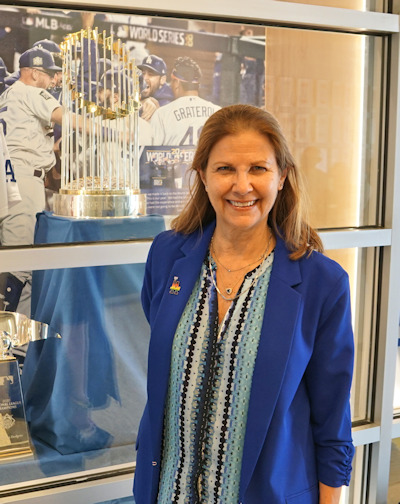
Even though she was often responsible for projects far away from her family’s home in Baltimore – and in the case of Dodger Stadium, on the opposite coast – she and her husband Bart Harvey “worked really hard to make certain that we always had a parent at home.” She would often work at a project Tuesday through Thursday, then fly home to be there Friday until early Tuesday. “That allowed me to be the car-pool mom on Mondays and Fridays.” No doubt much of the rest of her time spent at home was working on those projects remotely.
The fact that she was often the only woman in the meetings with construction supers and architects never held her back. “I never thought her gender mattered, because she had drive and passion for the project,” says Spear. “That’s what had an impact on Camden Yards and on her career.”
Kasten adds that her gender “is a non-factor as far as I’m concerned. It’s to her credit that I never think about it.”
“She was able to talk to everybody. Whether that was because she was a female or was from the South or was just a very nice person, I can’t say,” adds Lucchino. Naturally, he brought Smith into his latest venture, Polar Park, the new stadium for the Worcester Red Sox of the Triple-A East League. That makes four times he’s hired the Mississippian who was almost rejected by his Orioles in 1989.
One thing Lucchino has learned about Smith: she certainly knows that it’s the American League that has the Designated Hitter.
A shorter version of this article appeared in USA TODAY Sports Weekly. Used by permission.